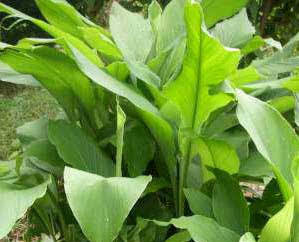Nabapatrika, also known as Nava Patrika, are the nine leaves worshipped during Durga Puja. ‘Nava’ means nine and ‘Patrika’ means leaves in Sanskrit and Navapatrika is part of rituals during Durga Puja and is installed on Saptami day. The leaves are also known as Nine Durgas. Nabapatrika symbolize nine deities worshipped in Hinduism. The nine plants are plantain (Banana), Kacu, Turmeric, Jayanti, Wood Apple (Bilva), Pomegranate, Ashoka, Arum and Rice Paddy or Dhanya. Here are the photos of the nine plants with the Goddess each plant represents:
Banana or Plantain - Goddess Brahmini
Plantain or Banana Tree symbolically represents Goddess Brahmani. In rituals plantain is referred as Rambha.
Kacu - Goddess Kalika
Kacu or Kachu symbolically represents Goddess Kali or Kalika. This plant has an edible root and is scientifically known as Colocasia Indica.
Turmeric - Goddess Durga
Turmeric Plant also known as Haridra or Halud represents Goddess Durga.
Jayanti Plant - Goddess Kartiki
Jayanti represents Goddess Kartiki. It is scientifically known as the Sesbania plant. Goddess Kartiki is here the consort of Lord Karik.
Bilva Leaves - Lord Shiva
Bilva or Vilva leaves represent Lord Shiva. Bel or Bilva leaves are the favorite of Lord Shiva and this is one of the most popular plants in rituals associated with Lord Shiva.
Pomegranate - Goddess Raktadantika
Pomegranate or Dadima or Darim represents Raktadantika.
Ashoka Tree - Goddess Shokarahita
Ashoka represents Goddess Sokarohita. The scientific name of this plant is Jonesia Asoka.
Mankachu - Goddess Chamundi
Mankachu or Arum Plant represents Goddess Chamundi. The scientific name of this plant is colocasia antiquorum.
Rice Paddy - Goddess Lakshmi
Rice paddy or Dhan represents Goddess Lakshmi.
It must be noted that there will be some regional variations in Nabapatrika. And also it is said that the leaves represents Nine Durga but Lord Shiva is included in the Navapatrika. Also Mankachu and Kachu are two different varieties of the same plant.
In the ritual, a life-sized statue is carved out of the banana plant and dressed like a beautiful bride with bilva fruits as her breasts, supported by a piece of sugarcane. The leaves are twisted like a bow to represent the head hair of the deity. Kachu (black taro), haridra (turmeric), jayanti (barley), dadima (pomegranate), ashoka, and dhanya (grain) represent the different parts of her body.
Nabapatrika is worshipped as both Goddess Durga and Lakshmi in some regions. Nabapatrika is also placed in front of a bilva tree. It is must be noted that although Nava Patrika are the symbols of Goddess Durga they are also associated with Surya, worship of sun.








